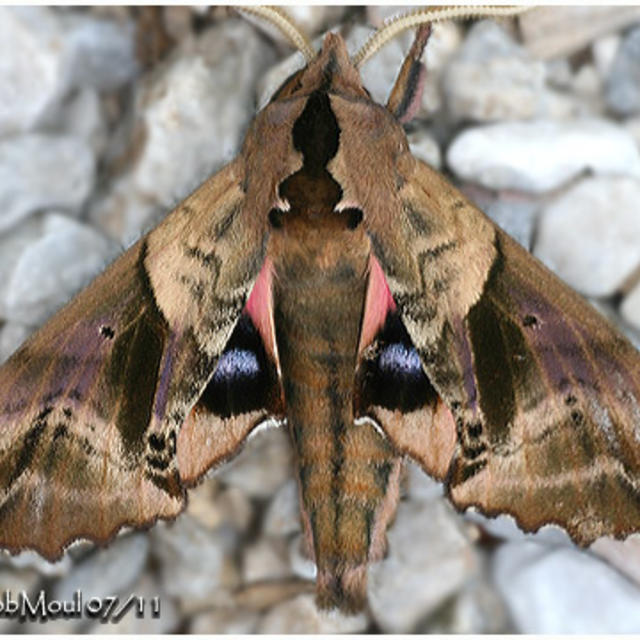Blinded sphinx
Paonias excaecata (J.E. Smith, 1797)
Family: Sphingidae
Subfamily: Sphinginae
Identification: Outer margins of the forewings are strongly scalloped, with white fringe on the concave part of the scallops. Forewing upperside is pale gray to dark reddish brown; underside has pink at the base. Upperside of hindwing is pale to dark brown with a broad pink patch at the base and a single blue eyespot.
Wing Span: 2 3/16 - 3 3/4 inches (5.5 - 9.5 cm).
Life History: Eggs hatch seven to eight days after they are laid. Fully-grown caterpillars pupate and overwinter in underground chambers.
Flight: . Three broods in Florida from March-October, several broods in Louisiana from March-September, and one or two broods in the rest of the range from May-September.
Caterpillar Hosts: A variety of deciduous trees including basswood (Tilia), willow (Salix), birch (Betula), hawthorn (Crataegus), poplar (Populus), oaks (Quercus), ocean spray (Holodiscus), and cherry (Prunus).
Adult Food: Adults do not feed.
Habitat: Deciduous woods, other wooded habitats, and suburbs.
Range: Throughout most of the United States and southern Canada from Nova Scotia and Maine south to Florida; west to British Columbia and Washington, northern California, and Arizona.
Conservation: Not usually required.
NCGR: G5 - Demonstrably secure globally, though it may be quite rare in parts of its range, especially at the periphery.
Management Needs: None reported.
Alternate Scientific Names:
Paonias excaecatus
Please donate!
We depend on donations to keep Butterflies and Moths of North America freely available. We want to express our gratitude to all who showed their support by making a contribution this year. You can donate to support this project at any time.
Advertise with us!
Do you have a product or service that you think would interest BAMONA users? If you would like to advertise on this website, contact us by email, or use the contact form and select the "Advertising" category.
Verified Sightings
Displaying 1 - 24 of 1340 verified sightings

Observation date: Jun 28, 2025
Submitted by: ExplorerMama
Region: Isanti County, Minnesota, United States
Verified by: Tom Middagh
Verified date: Nov 29, 2025

Observation date: Aug 03, 2025
Submitted by: saturniidluvr
Region: Ontario, Canada
Verified by: curtis.lehman
Verified date: Oct 22, 2025

Observation date: Sep 18, 2025
Submitted by: Ozark_Bill
Region: Iron County, Missouri, United States
Verified by: Ozark_Bill
Verified date: Sep 21, 2025

Observation date: Sep 17, 2025
Submitted by: Ozark_Bill
Region: St. Louis County, Missouri, United States
Verified by: Ozark_Bill
Verified date: Sep 21, 2025

Observation date: May 14, 2025
Submitted by: JulCus
Region: Collin County, Texas, United States
Verified by: stomlins701
Verified date: Sep 10, 2025

Observation date: Aug 26, 2025
Submitted by: scottj4hops
Region: Jessamine County, Kentucky, United States
Verified by: rogerdowner
Verified date: Aug 26, 2025

Observation date: Jun 08, 2020
Submitted by: Michele Pollock
Region: Brown County, Indiana, United States
Verified by: rogerdowner
Verified date: Aug 09, 2025

Observation date: Jul 24, 2025
Submitted by: Ozark_Bill
Region: St. Louis County, Missouri, United States
Verified by: jwileyrains
Verified date: Jul 30, 2025

Observation date: Jul 23, 2025
Submitted by: Nikkyroo
Region: Wexford County, Michigan, United States
Verified by: jwileyrains
Verified date: Jul 24, 2025

Observation date: Jul 19, 2025
Submitted by: Shane Miller
Region: Washington County, Pennsylvania, United States
Verified by: curtis.lehman
Verified date: Jul 22, 2025

Observation date: Jul 20, 2025
Submitted by: Jane Fuller
Region: Ontario, Canada
Verified by: curtis.lehman
Verified date: Jul 21, 2025

Observation date: Jul 13, 2025
Submitted by: dnight30
Region: Carroll County, New Hampshire, United States
Verified by: rogerdowner
Verified date: Jul 13, 2025

Observation date: Jul 04, 2025
Submitted by: Amyarkeveld
Region: Ontario, Canada
Verified by: curtis.lehman
Verified date: Jul 04, 2025

Observation date: Jun 30, 2025
Submitted by: Suzanne Briski
Region: Chippewa County, Wisconsin, United States
Verified by: Ilona L.
Verified date: Jul 01, 2025

Observation date: Jun 29, 2025
Submitted by: Savvyr222
Region: Quebec, Canada
Verified by: James Steen
Verified date: Jun 30, 2025

Observation date: Jun 25, 2025
Submitted by: SWilliams
Region: York County, Maine, United States
Verified by: Sue Gregoire
Verified date: Jun 26, 2025

Observation date: Jun 16, 2025
Submitted by: bobscafe
Region: British Columbia, Canada
Verified by: davidwdroppers
Verified date: Jun 22, 2025

Observation date: Jun 12, 2025
Submitted by: dnight30
Region: Carroll County, New Hampshire, United States
Verified by: rogerdowner
Verified date: Jun 15, 2025

Observation date: Jun 09, 2025
Submitted by: bobscafe
Region: British Columbia, Canada
Verified by: davidwdroppers
Verified date: Jun 12, 2025

Observation date: Jun 02, 2025
Submitted by: Hiker77
Region: Burke County, North Carolina, United States
Verified by: rogerdowner
Verified date: Jun 08, 2025

Observation date: May 23, 2025
Submitted by: weflybye
Region: Mason County, Washington, United States
Verified by: davidwdroppers
Verified date: May 24, 2025

Observation date: Jun 29, 2009
Submitted by: hank4044
Region: Lake County, Montana, United States
Verified by: davidwdroppers
Verified date: May 05, 2025

Observation date: Aug 23, 2024
Submitted by: garoul17
Region: Lonoke County, Arkansas, United States
Verified by: curtis.lehman
Verified date: Mar 18, 2025

Observation date: Sep 06, 2024
Submitted by: Cboat33
Region: Okmulgee County, Oklahoma, United States
Verified by: stomlins701
Verified date: Jan 24, 2025
- 1 of 56
- next ›

















